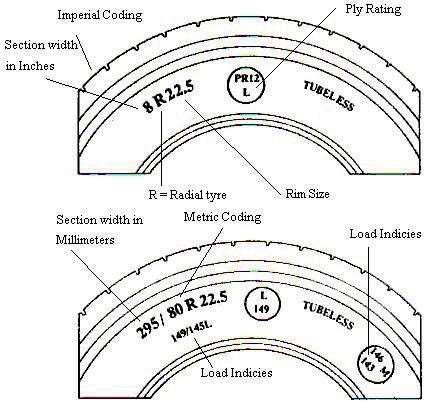Tyre information
Safe tyre loads need to be established and tyres fitted to a vehicle must meet Australian Design Rules (ADRs) and vehicle standard regulation.
The Heavy Vehicle (Vehicle Standards) National Regulation states the wheels and tyres fitted to an axle of a heavy vehicle must be of sufficient size and capacity to carry the part of the vehicle's gross mass transmitted to the ground through the axle.
The Tyre and Rim Association of Australia (TRAA) Standards Manual contains:
- load indices and speed rating tables
- safe tyre limits for tyres with alternate marking (e.g. ply ratings).
On this page:
- Tyre specifications
- Tyre terms and definitions
- Coding system
- Tyre sizes
- Imperial to metric weight conversions
Tyre specifications
The Australian Design Rules specifies tyre requirements, depending on the vehicle manufacture date:
Prior to 1 July 1988
- The sum of the safe tyre loads must equal the vehicle's on road permitted gross vehicle mass (GVM)—that is, the mass limit permitted for the particular vehicle on Queensland roads.
- This may be equal to or less than the manufacturer's GVM.
1 July 1988 to 30 June 1990
- Australian Design Rule 24/00 (third edition) states that the sum of the safe tyre loads must equal the manufacturer's GVM.
1 July 1990 to 30 November 2003
- Australian Design Rule 24/01 (third edition) states that the manufacturer must fit a tyre placard to the vehicle stating minimum tyre standards for the vehicle.
- For vehicles with a GVM or gross trailer mass (GTM) of 4.5t or more, the placard must also state individual axle loads.
1 December 2003 onwards
- Australian Design Rule 24/01 was repealed in 2003.
- This information is now included in Australian Design Rules 42/04 and 23/02 in relation to wheels, tyres and rims.
Tyre terms and definitions
| Aspect ratio | A measured term for the relationship between the height of the sidewall and the width of the tread area or cross section width of the tyre |
| Cord | The twisted fibre or filament of polyester rayon, nylon or steel which gives the tyre carcass and belts its strength |
| KPa | KiloPascal is a measurement of pressure |
| Load index | Relates to the maximum weight permitted for each tyre at a set inflation pressure when driven at maximum speed. Load indices are available at Vehicle Standard (Australian Design Rule 23/02 - Passenger Car Tyres) 2007 and Vehicle Standard (Australian Design Rule 96/00 - Commercial Vehicle Tyres) 2018 |
| Ply | A layer of rubber-coated cords that run on an angle of 40° across the tyre carcass |
| Ply rating | The amount of plies manufactured into the tyre (i.e. 6 ply or 8 ply) |
| PSI | Pounds per square inch, in relation to tyre pressure |
| Radial ply | A tyre with cords running radially from the bead at 90° to the centre of the tyre |
| Section width | The measured width of the tyre at its widest part when inflated to the manufacturer's recommendation |
| Speed rating | The maximum speed that the tyre can sustain for a 10min endurance without destroying itself and the vehicle. Approved speed ratings are available at Vehicle Standard (Australian Design Rule 23/02 - Passenger Car Tyres) 2007 and Vehicle Standard (Australian Design Rule 96/00 - Commercial Vehicle Tyres) 2018 |
Coding system
Tyres are marked with either the imperial or metric coding system.

Caption—diagram summarising imperial and metric codes found on approved tyres
To convert the section width from an imperial value (inches) to metric value (millimetres), multiply the section width in inches by 25.4.
For example, a tyre using the imperial system has a section width of 8 inches. To convert this value from inches to millimetres, multiply by 25.4 (i.e. 8 inches X 25.4 = 203mm).
Load indices indicate the manufacturer's safe tyre load (when displayed on a tyre). Load indices are displayed as: "149/146". The first number (e.g. "149") is the safe limit for the tyre when the tyre is fitted as a single tyre. The second number (e.g. "146") is the safe tyre limit when the tyre is fitted as part of a dual set.
Tyre sizes
Manufacturers may specify different masses (indicated by different load indices) for a given tyre size. For example, the manufacturer may have a heavy duty tyre for regional use that may carry a heavier load than another tyre of the same size designed for highway use only and having a lower load capacity.
It is recommended that the mass limit for each tyre size is confirmed by:
- contacting the manufacturer
- referencing the TRAA Standards Manual
- searching online for a tyre size chart specific to the tyres being inspected.
Imperial to metric weight conversions
To convert the mass from an imperial value (pounds) to metric value (tonnes), multiply the weight in pounds by 0.000454. For example 10,000 pounds X 0.000454 = 4.54 tonnes.
This converted metric weight is then recorded as the GVM for the vehicle.
If a mass limit is shown as CWT (centum weight), multiply the CWT weight by 112 to convert to pounds. For example, 50 CWT X 112 = 5,600 pounds. Then use the above calculation to convert pounds to tonnes. For example, 5,600 pounds X 0.000454 = 2.54 tonnes.
CWT (centum weight)
- CWT is a unit of mass defined in terms of pounds (i.e lb).
- The full name for CWT is "hundredweight"—"C" stands for centum (or hundred) and "WT" stands for weight.
- There are 20 hundredweights in a tonne.
More information
- Last updated 4 May 2022

